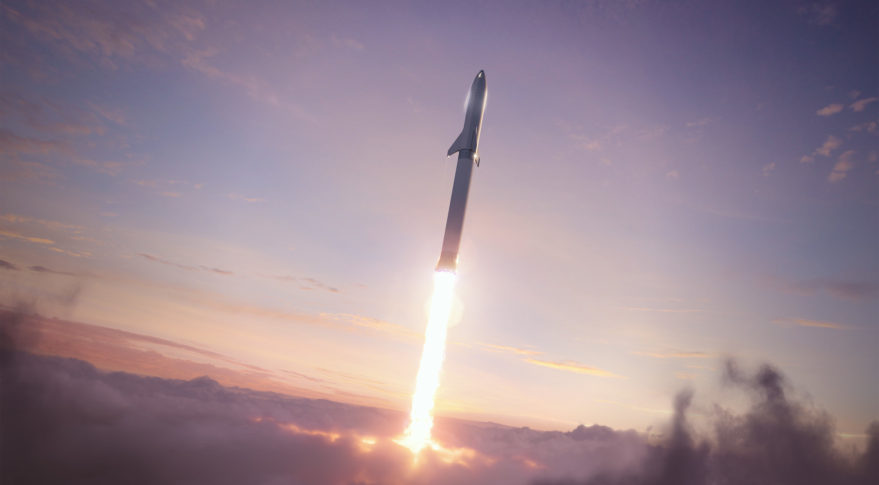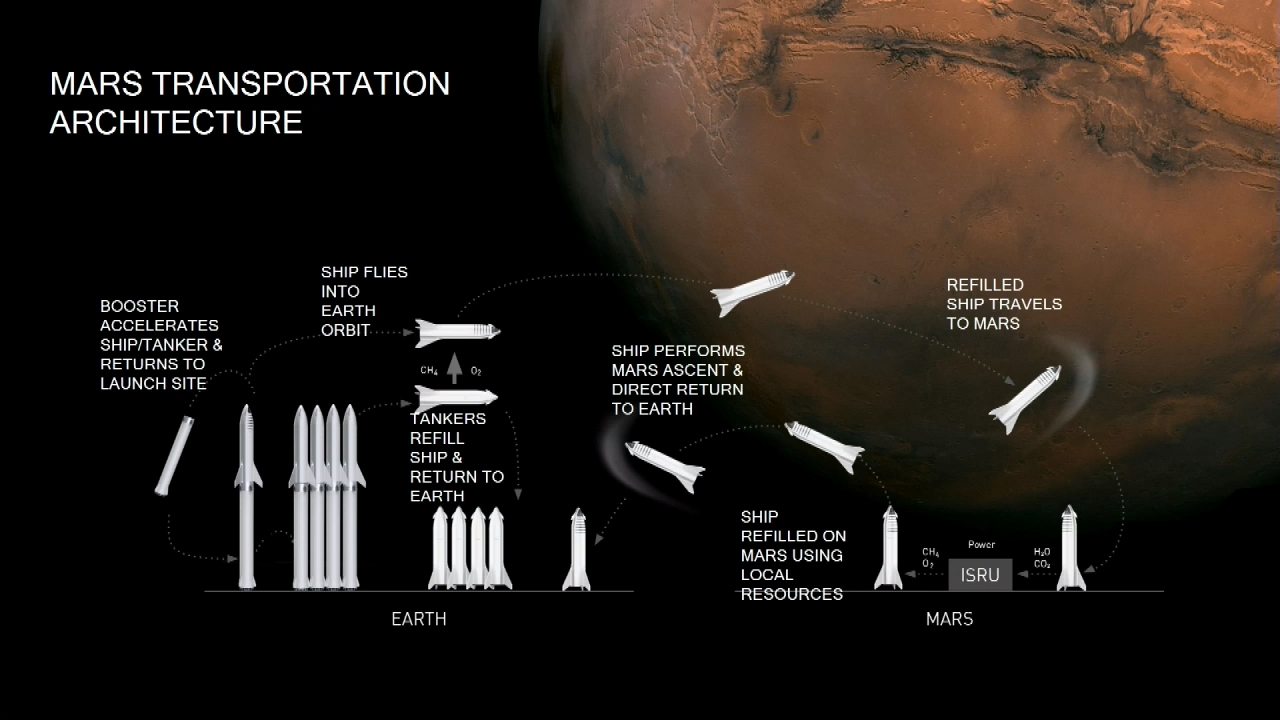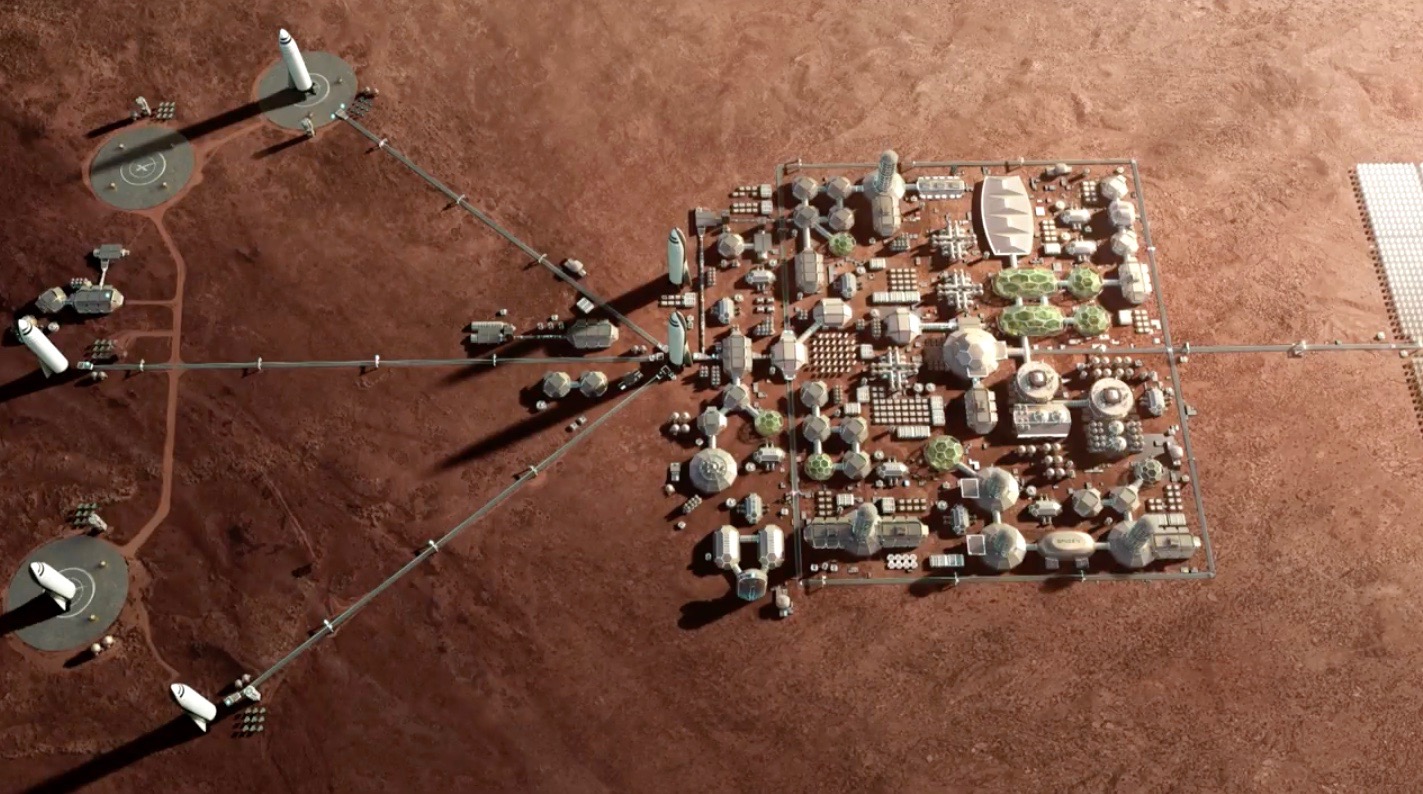How SpaceX's Starship Will Help Establish a Mars Base
SpaceX's Mars plans focus on interplanetary transportation, not building human habitats.

As NASA works toward its long-term goal of establishing a human settlement on Mars, SpaceX is fleshing out its plans to help NASA make that dream a reality.
The private spaceflight company, which regularly launches cargo to the International Space Station with the Falcon 9 rocket and will soon launch astronauts up there, is currently building an interplanetary spacecraft for Mars. Known as Starship, the rocket-spacecraft combo will be able to launch 100 passengers and large amounts of cargo to and from the Red Planet.
Before Starship can launch to Mars, it will start off launching commercial satellites as early as 2021, followed by a crewed flight around the moon in 2023. Although SpaceX has not given a timeline for its first missions to Mars, SpaceX founder Elon Musk has said that the first Mars base could be up and running in 2028. And while Musk shared some eye-catching artist illustrations depicting what he called "Mars Base Alpha" as an intricate network of buildings and infrastructure, SpaceX's plans for the Red Planet are not quite that extensive.
Gallery: Starship and Super Heavy: SpaceX's Mars-Colonizing Vehicles
"SpaceX very much is a transportation company," Paul Wooster, the principal Mars development engineer at SpaceX, said during a speech at the Humans to Mars Summit in Washington in May. He explained that SpaceX plans to build whatever infrastructure is necessary to support the company's Starship flights to and from Mars; that could include landing pads and refueling stations for the reusable rockets.
For its very first Mars missions, SpaceX will land at least two uncrewed cargo ships on the Red Planet before sending any humans there, Wooster said. Those cargo missions would bring supplies, such as life- support systems and power generators, that the first astronauts on Mars will need when they set up camp.
The first uncrewed Mars missions will also be tasked with confirming the presence of natural resources that can provide fuel for future two-way missions to the Red Planet, Wooster said. SpaceX wants to use water ice from the planet's surface and carbon dioxide from the Martian atmosphere to refuel Starships on Mars, enabling the rockets to return to Earth.
Breaking space news, the latest updates on rocket launches, skywatching events and more!
After those first two cargo missions, SpaceX will launch two crewed missions alongside two additional cargo-only flights to begin setting up a propellant production plant. At that plant, water and carbon dioxide will be converted into liquid methane and liquid oxygen, which fuel the rocket's engines.
So, while SpaceX intends to set up a transportation system for humans and cargo traveling to the Red Planet, the company won't be building an entire Mars base on its own. Musk has laid out his vision to create a million-person colony on Mars, but to establish that colony, SpaceX will have to work together with NASA and the agency's international partners and other commercial space companies. Several companies have already begun designing concepts for Mars habitats and have proposed orbital outposts similar to NASA's Lunar Gateway, which could serve as a waypoint for Starship and reduce the amount of fuel needed for return trips to Earth.
"SpaceX's intent, Elon's intent in founding SpaceX was to enable humanity to become a multiplanet species, allowing us to establish cities on Mars" and to inspire people, Wooster said. "So, while some aspects of [Musk's vision] are an artist's concept, the vehicle itself is very much in development now."
Hoppy Price, chief engineer of NASA's robotic Mars exploration program, spoke with Wooster at the Humans to Mars Summit, suggesting that NASA is interested in SpaceX's Starship. However, the agency won't be fully committed to using Starship for its first human Mars missions until SpaceX has proven that the vehicle is ready for flight. NASA is also considering using its own Space Launch System megarocket for Mars, but the development of that new rocket has faced years of delays.
"We're quite happy to help out NASA in their overall plans for going to the moon and Mars," Wooster said, adding that SpaceX must first focus on testing Starship to make sure it can leave Earth and return safely.
Starship itself is still in the design phase, and Musk is expected to announce Starship's latest design update on Aug. 24. However, SpaceX has already begun testing a small Starship prototype called Starhopper, which is scheduled to make its biggest "hop" yet this weekend (Aug. 16-18).
Wooster said SpaceX is still on track to start launching humans to Mars in the mid-2020s. That time frame likely has something to do with the fact that the next suitable launch windows, based on the positions of Earth and Mars, will occur in 2024 and 2026. But while SpaceX is known for its ambitious ideas, Musk also has a history of offering ambitious timelines. Before we'll really know when the first Starship missions can launch to Mars, SpaceX will first have to prove that the rocket can get there safely.
- SpaceX's Mars Colony Plan: How Elon Musk Plans to Build a Million-Person Martian City
- Tickets to Mars Will Eventually Cost Less Than $500,000, Elon Musk Says
- How Space Station and Moon Missions Will Prep Astronauts for Mars
Email Hanneke Weitering at hweitering@space.com or follow her @hannekescience. Follow us on Twitter @Spacedotcom and on Facebook.

Hanneke Weitering is a multimedia journalist in the Pacific Northwest reporting on the future of aviation at FutureFlight.aero and Aviation International News and was previously the Editor for Spaceflight and Astronomy news here at Space.com. As an editor with over 10 years of experience in science journalism she has previously written for Scholastic Classroom Magazines, MedPage Today and The Joint Institute for Computational Sciences at Oak Ridge National Laboratory. After studying physics at the University of Tennessee in her hometown of Knoxville, she earned her graduate degree in Science, Health and Environmental Reporting (SHERP) from New York University. Hanneke joined the Space.com team in 2016 as a staff writer and producer, covering topics including spaceflight and astronomy. She currently lives in Seattle, home of the Space Needle, with her cat and two snakes. In her spare time, Hanneke enjoys exploring the Rocky Mountains, basking in nature and looking for dark skies to gaze at the cosmos.


